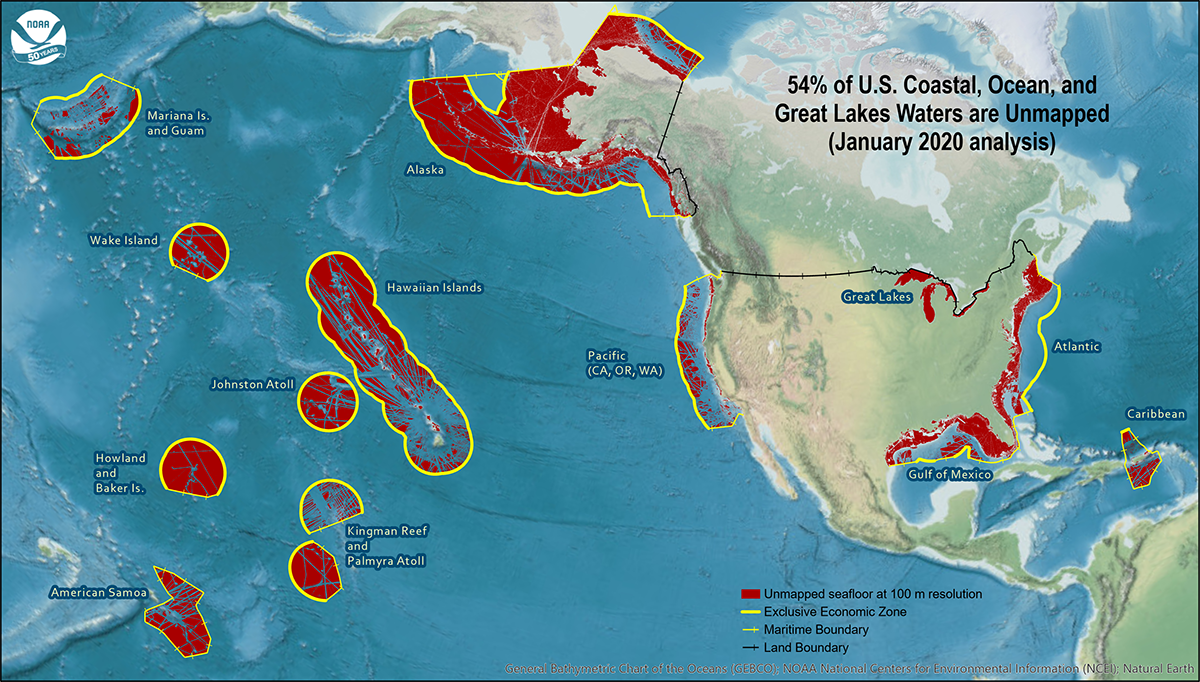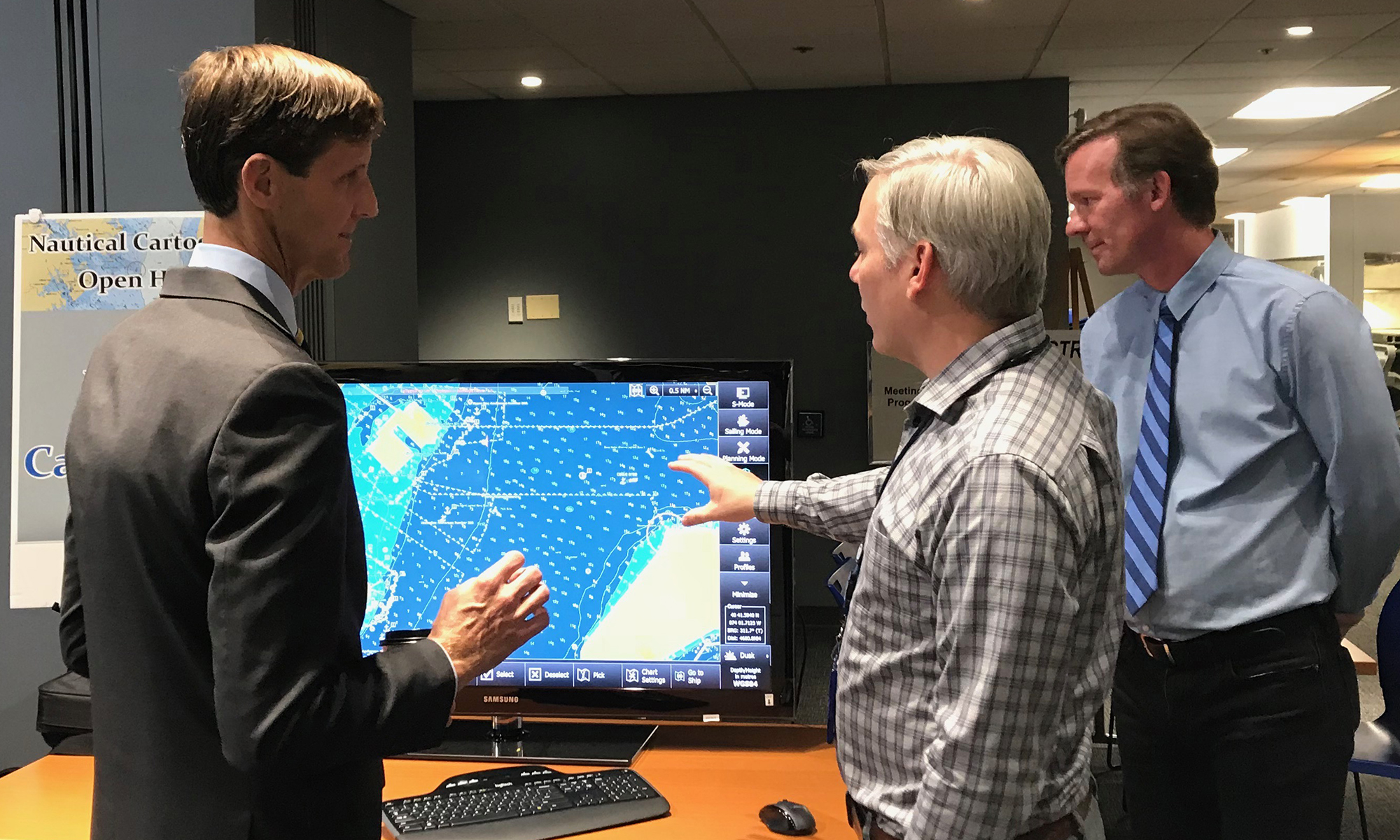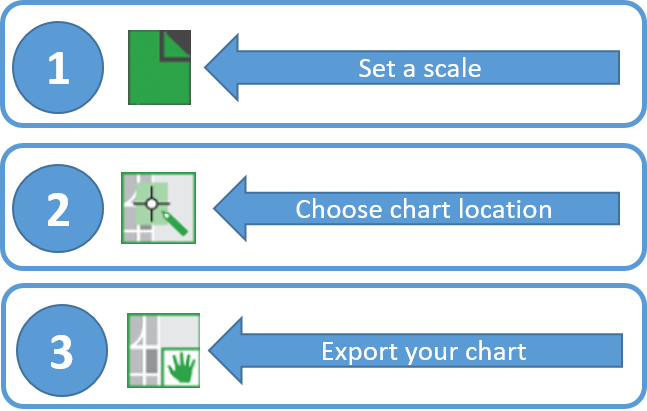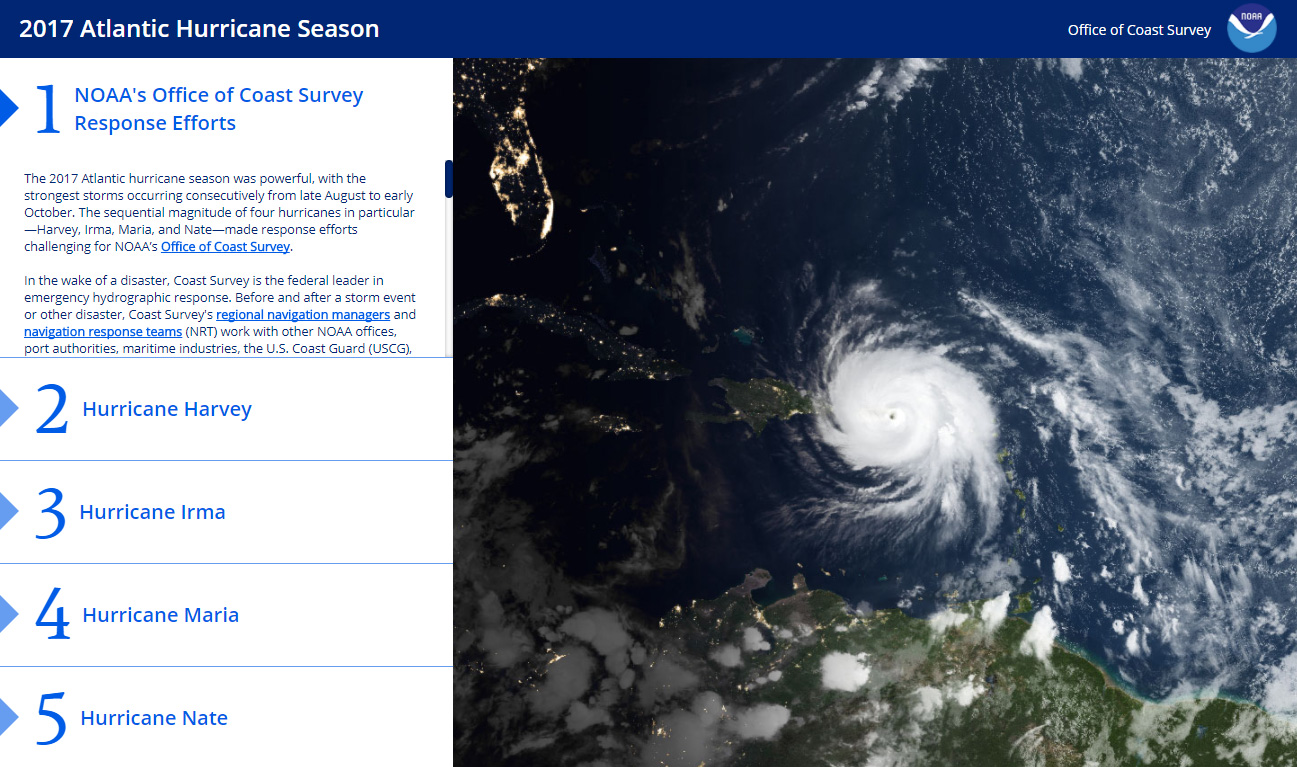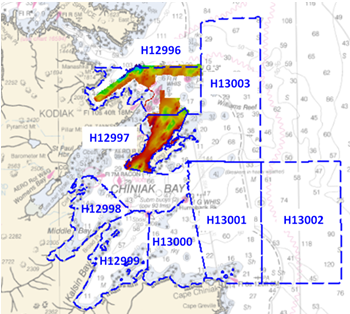NOAA released the first annual report on the progress made in mapping U.S. ocean, coastal, and Great Lakes waters. The depth, shape, and composition of the seafloor are foundational data elements that we need to understand in order to explore, sustainably develop, conserve, and manage our coastal and offshore ocean resources. The 2019 Presidential Memorandum on Ocean Mapping of the United States Exclusive Economic Zone and the Shoreline and Nearshore of Alaska and the global Seabed 2030 initiative make comprehensive ocean mapping a priority for the coming decade. The Unmapped U.S. Waters report tracks progress toward these important goals.
Continue reading “NOAA announces new progress report on mapping U.S. ocean, coastal, and Great Lakes waters”NOAA welcomes local and international attendees at 2018 Nautical Cartography Open House
Last week NOAA Coast Survey welcomed approximately 170 attendees representing 17 countries to the 2018 Nautical Cartography Open House. Industry partners, members of the public, and other government agencies attended, including the Bureau of Ocean Energy Management, Naval Hydrographic and Oceanic Service (SHOM) from France, Canadian Hydrographic Service, Dalian Naval Academy, National Taiwan Ocean University, and the Joint Hydrographic Center/Center for Coastal and Ocean Mapping (JHC/CCOM).
Continue reading “NOAA welcomes local and international attendees at 2018 Nautical Cartography Open House”
NOAA hosts 2018 Chart Adequacy Workshop
On July 23, NOAA Coast Survey hosted a three-day Chart Adequacy Workshop that included participants from 13 countries. This is the fourth Chart Adequacy Workshop held at NOAA’s Silver Spring, Maryland campus.

The main goal of the workshop is to provide training for professional cartographers and hydrographers on techniques for assessing nautical chart adequacy using publicly-available information, such as satellite images and maritime automatic identification system (AIS) data. The participants received an overview on Coast Survey datasets, processes, and requirements for nautical charts. They also learned about preprocessing hydrographic data, such as loading charts, uploading imagery, and applying electronic navigation charts (ENCs) and AIS point data. Through a series of lab units, the attendees practiced performing the concepts they learned. Continue reading “NOAA hosts 2018 Chart Adequacy Workshop”
Poster symposium marks milestone for inaugural class of the NOAA certification program in nautical cartography

Students of NOAA’s certification program in nautical cartography completed their final projects and presented them along with other Master of Professional Studies in GIS students during a poster symposium at the University of Maryland’s Department of Geographical Sciences. At the event, NOAA students explained their capstone projects and described how their research benefits nautical charting at NOAA. Project topics included:
- Improving Shoreline Application to NOAA Electronic Navigational Charts, Megan Bartlet
- An Automated Approach to Generate Nautical Vector Features from Raster Bathymetric Attributed Grid Data, Noel Dyer
- Developing a Rasterization Procedure for Vector Chart Data, Christie Ence
- NOAA Chart Discrepancies: A Temporal and Spatial Analysis for Navigation Response Teams, Lt. Cmdr. Matt Forney
- Airborne Lidar Bathymetry’s Impact on NOAA Charts, Andres Garrido
- Validating and Refining the Proposed Rescheming of NOAA Electronic Navigational Charts, Colby Harmon
- High Resolution Bathymetry as an Alternative to Charting Controlling Depths in U.S. Army Corps of Engineers Channels, Craig Winn
- Satellite Derived Bathymetry: An Alternative Analysis to Nautical Chart Updates, Aleah Worthem
Online NOAA Custom Chart lets boaters create their own charts
A prototype version of a powerful new online tool, NOAA Custom Chart, is now available for boaters and other nautical chart users. The application enables users to define the scale and paper size of custom-made nautical charts centered on a position of their choosing. Once the functionality of this prototype is fully developed, NOAA Custom Chart will be an easy way for boaters to create a paper or digital back-up for the electronic chart system or other GPS-enabled chart display that they are using on board.
Continue reading “Online NOAA Custom Chart lets boaters create their own charts”
NOAA Office of Coast Survey wraps up a busy 2017 hurricane season
The 2017 Atlantic hurricane season was powerful, with the strongest storms occurring consecutively from late August to early October. The sequential magnitude of four hurricanes in particular—Harvey, Irma, Maria, and Nate—made response efforts challenging for NOAA’s Office of Coast Survey. Coast Survey summarized this season’s response efforts along with the efforts of NOAA Ship Thomas Jefferson (operated by NOAA’s Office of Marine and Aviation Operations) in the following story map. Continue reading “NOAA Office of Coast Survey wraps up a busy 2017 hurricane season”
NOAA Ship Rainier surveys the waters around Kodiak Island
by ENS Michelle Levano
Kodiak Island is the 2nd largest island in the United States; it is part of the Kodiak Island Archipelago, a group of islands roughly the size of Connecticut. Due to the island’s location in the Gulf of Alaska and North Pacific Ocean, Kodiak is ranked as third in commercial fishing ports in the U.S. in terms of value of seafood landed. In 2015, the Port of Kodiak was responsible for 514 million pounds of fish and $138 million of product. More than one-third of the jobs in Kodiak are related to the fishing industry.
The Port of Kodiak is home to more than 700 commercial fishing vessels, and has more than 650 boat slips and three commercial piers that can dock vessels up to 1,000 feet. In addition to fishing, Kodiak is the hub of the Gulf of Alaska container logistics system, serving the southwest Alaskan communities with consumer goods and outbound access to the world’s fish markets. Continue reading “NOAA Ship Rainier surveys the waters around Kodiak Island”
Introducing NOAA’s new ENC Direct to GIS
 Features in an electronic navigational chart represent thousands of pieces of data describing the coastal and marine environment. This data includes coastal topography, bathymetry, landmarks, geographic place names, and marine boundaries for the specific geographic region encompassed by the chart. What if we could aggregate the ENC features into a geospatial database? Such a product would provide a continuous depiction of the U.S coastal and marine environment.
Features in an electronic navigational chart represent thousands of pieces of data describing the coastal and marine environment. This data includes coastal topography, bathymetry, landmarks, geographic place names, and marine boundaries for the specific geographic region encompassed by the chart. What if we could aggregate the ENC features into a geospatial database? Such a product would provide a continuous depiction of the U.S coastal and marine environment.
Continue reading “Introducing NOAA’s new ENC Direct to GIS”

